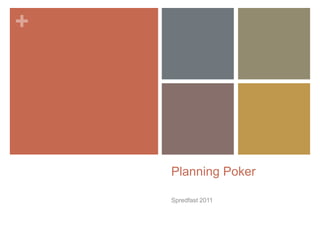planning poker
- 1. Planning Poker Spredfast 2011
- 2. Planning Poker Planning Poker is attributed to Greening and is fairly a recent development (2002) Planning Poker combines expert opinion, analogy, and disaggregation into a fun approach to estimating that results in quick, unambiguous estimates. Participants in Planning Poker include the entire development team (Developers and QA)
- 3. Story PointsUsed to denote a name of the estimating unit Derived from calling a unit of work a user story Based on a combination of size and complexity of the work Produces Unitless but numerically relevant numbers A 10 point story would take twice as long as a 5 point story
- 4. Story Points Have three key benefitsForces the use of relative estimating Focuses us on estimating the size, not the duration Puts estimates in units we can add together Uses Fibonacci sequence â 1, 2, 3, 5, 8, 13, 21, âĶ
- 5. Planning Poker - StepsEach estimator is given a deck of cards, each card has a valid estimate written on it Customer/Product owner reads a story and the team briefly discusses Each estimator selects a card thatâs his/her estimate Cards are turned over so all can see them Discuss Differences (especially outliers) Re-estimate until estimates converge
- 6. Planning Poker â Why it WorksThose who do the work, will estimate the work Estimators are required to justify their estimates Focuses most estimates within an approximate one order of magnitudeCombining of individual estimates through group discussion leads to better estimates Estimates are constrained to a set of values so we donât waste time in meaningless arguments
- 7. Planning Poker â Side EffectsGreater understanding of work to be completed Expectation setting Implementation hintsHigh Level architecture and design discussion Ownership of estimate






